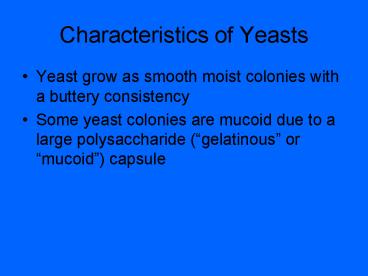Characteristics of Yeasts - PowerPoint PPT Presentation
1 / 10
Title:
Characteristics of Yeasts
Description:
... of Yeasts. Yeast grow as smooth moist colonies with a buttery consistency. Some yeast colonies are mucoid due to a large polysaccharide ('gelatinous' or ' ... – PowerPoint PPT presentation
Number of Views:1547
Avg rating:3.0/5.0
Title: Characteristics of Yeasts
1
Characteristics of Yeasts
- Yeast grow as smooth moist colonies with a
buttery consistency - Some yeast colonies are mucoid due to a large
polysaccharide (gelatinous or mucoid) capsule
2
Butyrous Glabrous Growth of Yeast
3
Characteristics of Yeasts
- Yeast typically cannot be identified by
morphologic features alone because they lack
variety in their appearance - The identity of yeast is determined by a
combination of morphologic and biochemical
criteria
4
Characteristics of Molds
- Moulds (molds) are filamentous multicelled fungi
that reproduce sexually and/or asexually in a
variety of ways - Long thin tube-like structures (germ tubes)
emanate from sexual or asexual propagules to
form septate or non-septate hyphae - Hyphae tend to form branches
- Intertwining hyphae form matted growth know as
the mycelium
5
Initiation of Hyphal Growth
Propagule
Germ tube
6
Characteristics of Molds
- Crosswalls may develop and divide the elongated
germ tube (now called a hyphae) into sections.
This is known as septate hyphae - In one group of fungi (the zygomycetes)
crosswalls are absent or rare (non-septate or
aseptate)
7
Septate Fungal Hyphae
Septa
8
Nonseptate (or sparsely septate) Hyphae
9
Characteristics of Molds
- Hyphae that grow on top of the substrate and
protrude into the air intertwine to form aerial
mycelium (vs vegetative mycelia)
10
Characteristics of Molds
- Asexual propagules that develop laterally or
terminally from hyphae (conidiophores) are
conidia (pleural) or conidium (singular). The
cells in the hyphae from which they form are
termed conidiogenous cells. - 2 forms of conidial development
- 1.Blastic enlargement or "blowing out" of a
conidial initial before being delimited by a
septum. - 2.Thallic septum formed prior to conidial
enlargement

